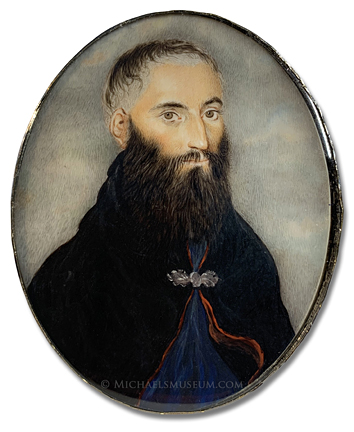| |
American: Artist Unknown


Religious Figure of Spanish Colonial Louisiana
Spanish-American
circa 1780-1785
artist unknown
2 1/2 x 3 inches
watercolor on ivory; housed in a sterling silver case with a burnished gold bezel
This is a most interesting portrait miniature. It originated in New Orleans and is estimated to date to the period of 1780-1785, when Louisiana was a Spanish Colony.* When acquired for the Collection, it was originally assumed that the subject of the portrait was a Jesuit missionary. Further research leads us to believe that is unlikely, however, as the Jesuits were expelled from Louisiana in 1763 and did not resume their work in the territory until around 1830.
Dr. Emilie Gagnet Leumas, Archivist of the Archdiocese of New Orleans, was kind enough to examine a high resolution photograph of the miniature and observed that the subject's hair appears to possibly be styled in a tonsure cut, a practice that was common among Capuchin monks of the period. Dr. Leumas also noted that Spanish Capuchins were prevalent in Louisiana in the late eighteenth century. (A Spanish Capuchin friar by the name of Antonio de Sedella was, in fact, the leading religious authority of the Catholic Church in New Orleans from 1774 to 1803.) It is important to note, however, that Capuchins, being an offshoot of the Franciscans, eschewed wealth and adopted lives of austerity. In contrast, the subject of this portrait miniature wears robes that appear to be made of fine material, and his cloak appears to be held in place with an ornate, sterling silver clasp (certainly not indicative of austerity). The miniature is, additionally, housed in a solid silver case with a burnished gold bezel, indicating that it was likely commissioned by someone of greater than average means.
Rather than being a Capuchin monk, it is instead believed that the subject was either a Catholic priest from Havana (until 1793, Louisiana was part of the Archdiocese of San Cristobal de la Habana) or, perhaps more likely, the son of a wealthy Spanish colonist. The subject appears to be a fairly young man, after all. Might he have been a seminarian or a novice preparing to enter the priesthood; and might his wealthy parents have commissioned the portrait as a memento that they themselves retained? The subjects gentle gaze towards the viewer reinforces this theory. We will likely never know the answers to these questions; but the young man's image has survived two and half centuries and provides us now a rare glimpse into life in Spanish Colonial America.
*Spain acquired Louisiana from France in 1762, at the end of the Seven Years' War. The territory was governed by Spain until 1800, at which point it reverted back to France. The United States later acquired the Louisiana Territory from France in 1803, in a transaction known as "The Louisiana Purchase".
|
|